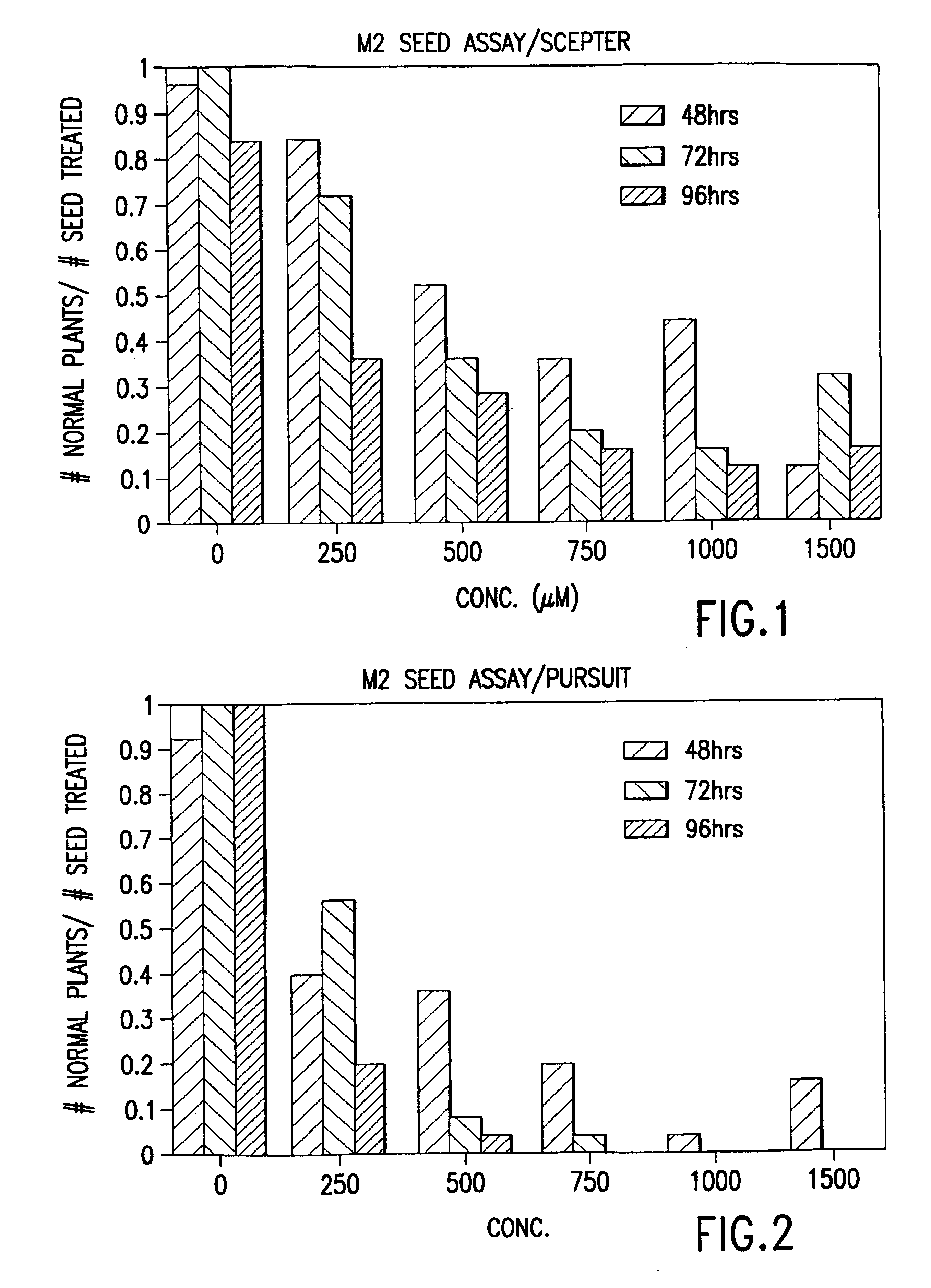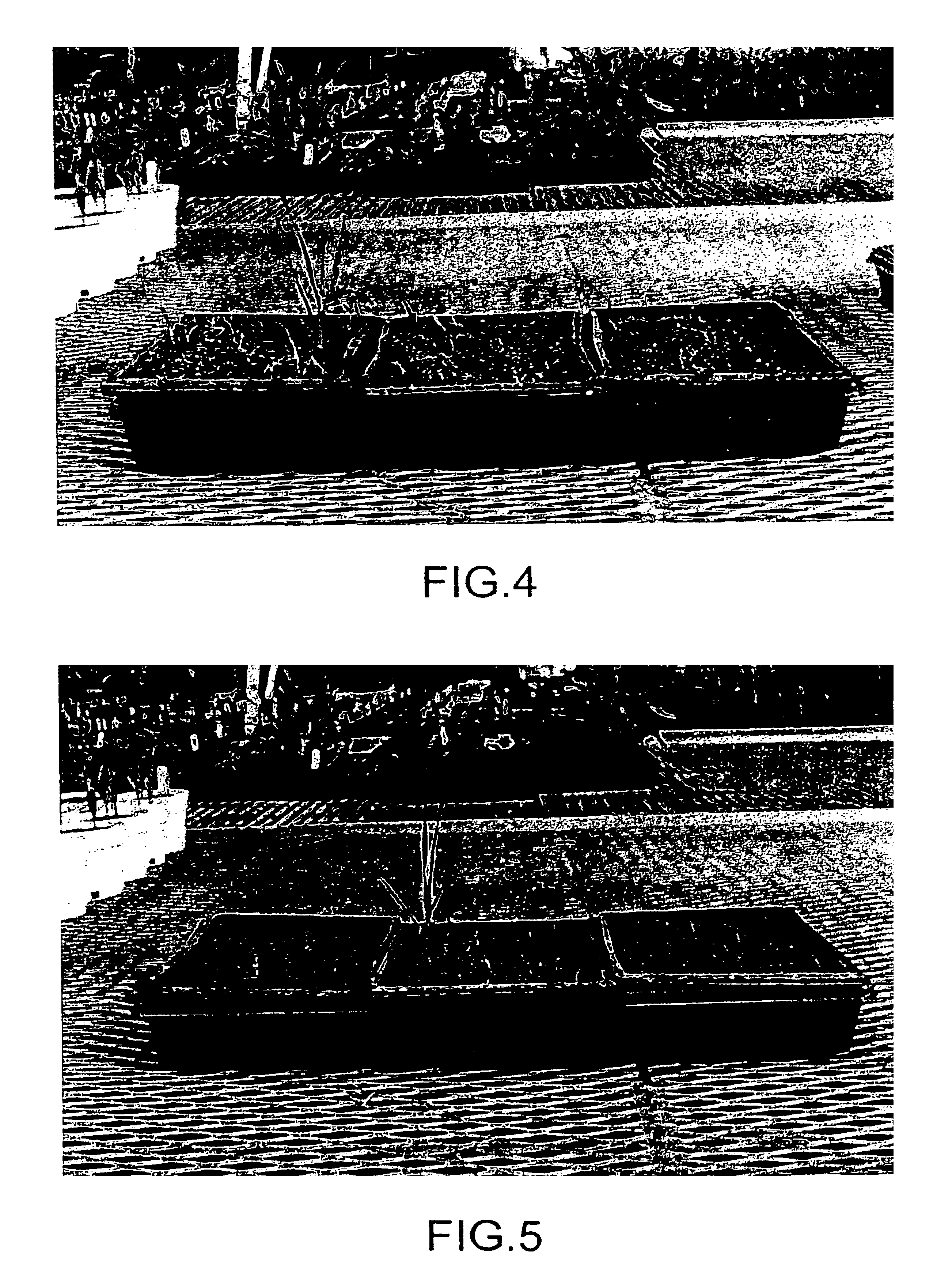Ahas inhibiting herbicide resistant wheat and method for selection thereof
- Summary
- Abstract
- Description
- Claims
- Application Information
AI Technical Summary
Benefits of technology
Problems solved by technology
Method used
Image
Examples
example 1
Development of a Two Step Seed Screen
1. Seed Mutagenesis
[0074]Five thousand seeds of “Fidel”, a French winter wheat, are mutagenized following the procedure of Kueh and Bright (Kueh, J. S. H. and Bright, S. W. J., Planta, 153, 166-171 (1981). The wheat seeds are soaked in water for 18 hours at 5° C. and then air is bubbled through the seeds for six hours at 20° C. This is followed immediately by treatment with 1 mM sodium azide, a chemical mutagen, at pH3 for two hours. The seeds are rinsed with water for 30 minutes and then spread in a shallow layer onto paper towels to dry. Once dry, the seeds are planted in the field.
[0075]The wheat plants are grown to maturity and the M2 seed is harvested. Approximately 117,000 wheat seeds are harvested and used to screen for imidazolinone-resistant wheat. The germination frequency of this material is 100%.
2. Step 1: Seed Soak
[0076]Following the protocol developed by Sebastian and Chaleff, wheat seeds are surface disinfested in 70% EtOH for 30 s...
experiment 1
[0077]ARSENAL™: 0, 1, 10, 50, 100, 500 uM[0078]SCEPTER™: 0, 1, 10, 50, 100, 500 uM
for 48 hours. Each treatment is replicated four times. (ARSENAL™ and SCEPTER™ are registered trademarks of American Cyanamid Company. ARSENAL™ is 2-(4-isopropyl-4-methyl-5-oxo-2-imidazolin-2-yl)-nicotinic acid and is described in U.S. Pat. No. 4,798,619; SCEPTER™ is 2-(4-isopropyl-4-methyl-5-oxo-2-imidazolin-2-yl)-3-quinolinecarboxylic acid and is described in U.S. Pat. No. 4,798,619.)
[0079]ARSENAL inhibits seed germination and seedling growth with increasing concentration. While some potential false positives are observed visually at concentrations up to 50 uM, higher concentrations totally inhibit seedling growth. At these concentrations, 100 and 500 uM, some susceptible seeds germinate, but the shoots are small, twisted and generally abnormal in appearance.
[0080]While SCEPTER™ also inhibits seedling growth with increasing concentration, by three to four weeks, the seedlings recover, as observed visu...
experiment 2
[0081]ARSENAL™ 0, 10, 50, 100, 500 uM[0082]SCEPTER™ 0, 100, 250, 500, 750, 1000 uM
for 48 hours. Each treatment is replicated two times.
[0083]ARSENAL™ is retested at the same concentrations as the previous experiment and the same results are obtained as described above. In this study, the SCEPTER™ concentration is increased to a maximum of 1000 uM. By the end of the study, it is evident from visual observation that this concentration is still not high enough to prevent “escapes”. The duration of exposure to the herbicide also appears to have an effect on the number of false positives. In experiment 1, the seeds soak for a few hours longer and some root elongation occurs; however, the seeds in this experiment do not all exhibit radicle emergence when the herbicide treatment is terminated. The effect of the duration of the seed soak upon the herbicide concentration necessary to prevent “escapes” is investigated in the following experiment.
PUM
| Property | Measurement | Unit |
|---|---|---|
| Height | aaaaa | aaaaa |
| Height | aaaaa | aaaaa |
| Height | aaaaa | aaaaa |
Abstract
Description
Claims
Application Information
 Login to View More
Login to View More - R&D
- Intellectual Property
- Life Sciences
- Materials
- Tech Scout
- Unparalleled Data Quality
- Higher Quality Content
- 60% Fewer Hallucinations
Browse by: Latest US Patents, China's latest patents, Technical Efficacy Thesaurus, Application Domain, Technology Topic, Popular Technical Reports.
© 2025 PatSnap. All rights reserved.Legal|Privacy policy|Modern Slavery Act Transparency Statement|Sitemap|About US| Contact US: help@patsnap.com



